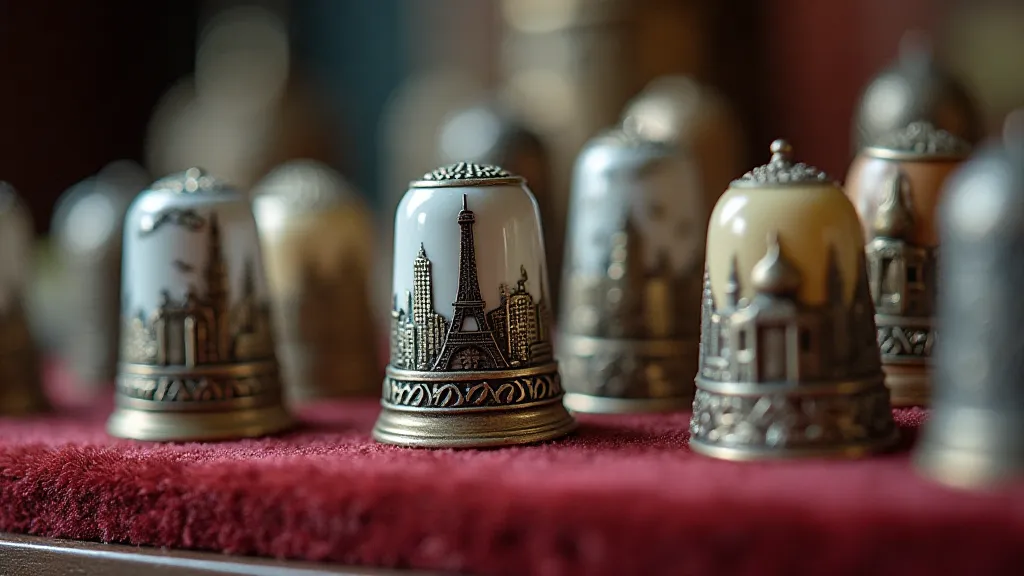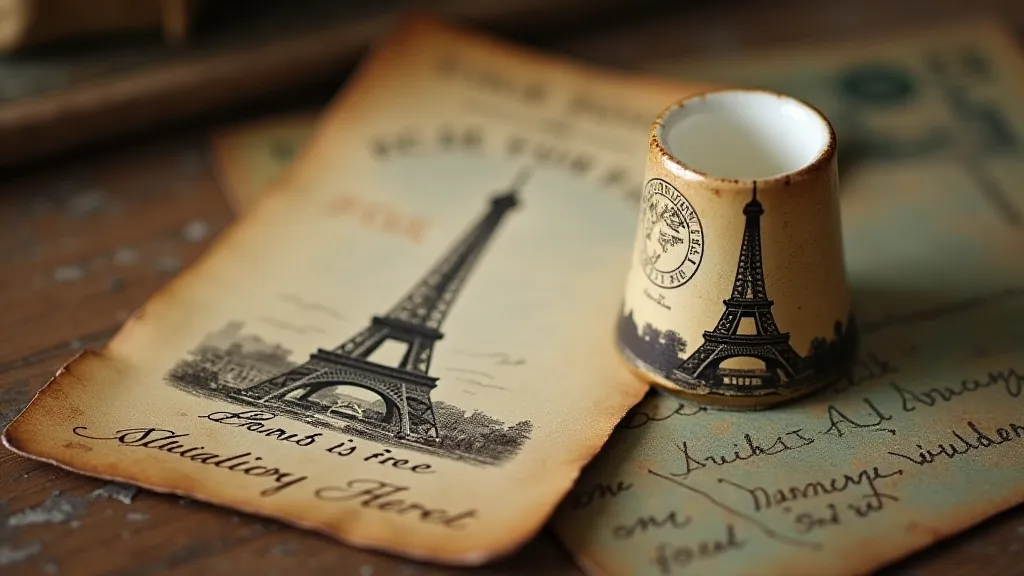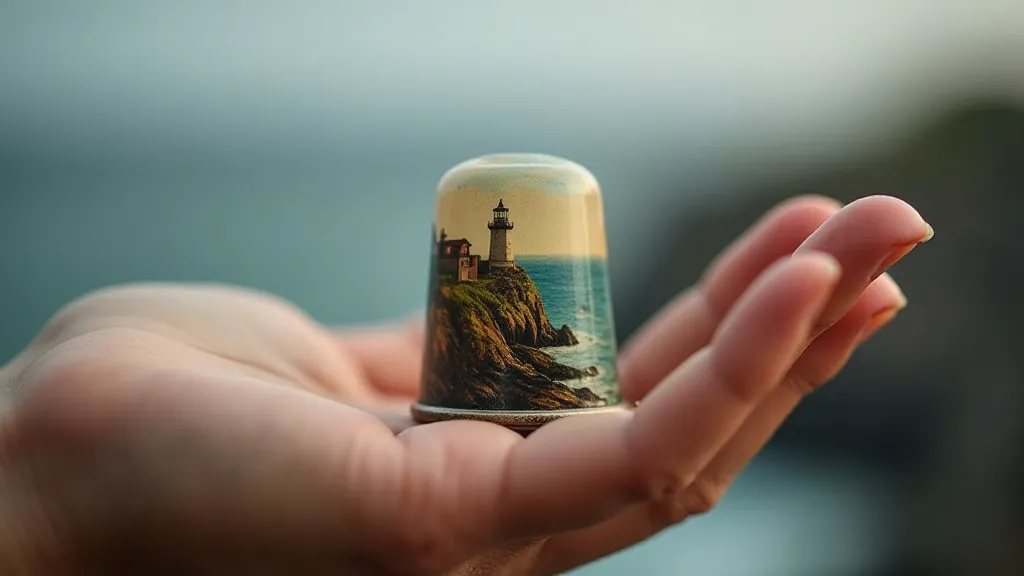The Cartographer's Thumb: Thimbles as Markers of Geographical Curiosity
There's a peculiar magic in holding a tiny thimble. It's not just a tool, a discarded remnant of a bygone era of meticulous sewing. It’s a miniature vessel, a silent witness to countless hours of focused craft. And, when those thimbles commemorate a place – a city, a mountain range, a distant shore – they become something more: tangible echoes of a burgeoning global curiosity, miniature cartographic wonders held in the palm of your hand. The history of these collectible thimbles isn’t just about fabric and needlework; it’s interwoven with the threads of exploration, travel, and a deep, abiding human desire to map and understand the world.
My grandmother, Elsie, was a master seamstress. Her hands, perpetually stained with dye and smelling faintly of lavender, were her most prized tools. I remember, as a child, watching her carefully thread a needle, often using a simple, silver thimble. It wasn’t remarkable, just functional. But she had a box, tucked away in the bottom drawer of her sewing table, filled with other thimbles – a glittering collection she’d started accumulating decades ago. These weren’t for sewing; they were reminders. Each one represented a place she’s dreamed of visiting, a place she’s read about in worn travelogues, or, later in life, a place she was fortunate enough to experience firsthand. They weren't just thimbles; they were miniature postcards from the world.

The Rise of the Commemorative Thimble
The popularity of commemorative thimbles really took off in the mid-20th century, coinciding with the post-war boom in international travel and a growing accessibility to information about different cultures. Before the advent of affordable air travel, journeys were grand, often life-altering expeditions. Coming home with a small memento, something that could be held and admired, became a cherished tradition. The first wave of themed thimbles largely focused on national pride – images of flags, national emblems, and portraits of royalty. But the scope quickly broadened. As tourism exploded, manufacturers seized the opportunity to produce thimbles showcasing specific cities, landmarks, and natural wonders.
The craftmanship involved in producing these early commemorative thimbles is often remarkable. Many were hand-painted, showcasing an incredible attention to detail. Think of a tiny, porcelain thimble depicting the canals of Venice, the gondolas rendered with painstaking precision. Others were made from pressed metal, featuring embossed images of the Grand Canyon or Mount Everest. The materials themselves reflected the perceived character of the commemorated place – a sturdy pewter thimble for a rugged mountain range, delicate glass for a shimmering coastline.
Beyond the Material: Telling Stories
What truly elevates a commemorative thimble from a mere trinket to a treasured collectible is the story it holds. It’s not just about the place; it’s about the *feeling* the place evokes. A thimble depicting the Roman Forum might symbolize a connection to history, to empires and the rise and fall of civilizations. A thimble featuring a Scottish loch might call to mind misty landscapes and ancient folklore. These tiny objects became tangible links to experiences, or at least to the *idea* of those experiences, for those who collected them.
I recall one particular thimble in Elsie’s collection that she always held up with a wistful smile: a simple, dark blue glass thimble depicting the Matterhorn. She's never been to Switzerland, but she'd spent countless hours poring over photographs of the majestic mountain in National Geographic magazines. That thimble wasn’t just a representation of a place; it was a symbol of her aspirations, her yearning for adventure, and her appreciation for the raw beauty of the natural world. It was, in a way, her personal shortcut to a distant landscape.

Restoration and Preservation – Gentle Care for Tiny Treasures
Like any antique, commemorative thimbles are susceptible to wear and tear. Tarnish on silver thimbles, chips on porcelain, and cracks in glass are all common issues. While a full restoration is often unwise – removing the patina can diminish the historical value – gentle cleaning and careful storage can significantly extend their lifespan.
For silver thimbles, a mild soap and water solution, followed by a careful polishing with a soft cloth, can remove surface tarnish. Porcelain thimbles should be handled with extreme care, as they are easily chipped. Avoid harsh chemicals and abrasive cleaners. Glass thimbles are relatively durable, but cracks can be exacerbated by temperature changes. Storing thimbles in a climate-controlled environment, cushioned from impact, is crucial for preserving their integrity.
My grandmother never cleaned her thimbles obsessively. She believed that the marks and imperfections – the tiny scratches, the faint discoloration – were part of their story. They were evidence of their journey, tangible reminders of the passage of time. And she was right. It is these imperfections that truly give antique thimbles their charm and character.
The Legacy of Elsie’s Collection
Elsie’s collection has passed to me, and I cherish each piece. It’s more than just a collection of tiny objects; it’s a window into her life, her dreams, and her enduring curiosity about the world. It reminds me of her gentle hands, her infectious enthusiasm, and her unwavering belief in the power of dreams. Holding one of those miniature cartographic wonders, I feel a profound connection to her, and to the vast, interconnected world she so admired. And perhaps, it inspires me to add a few more places to *my* own collection – places I, too, hope to explore and experience firsthand.

The cartographer's thumb, in this context, isn't about the act of drawing maps; it’s about the human impulse to understand and connect with the world around us, one tiny, beautifully crafted thimble at a time.





